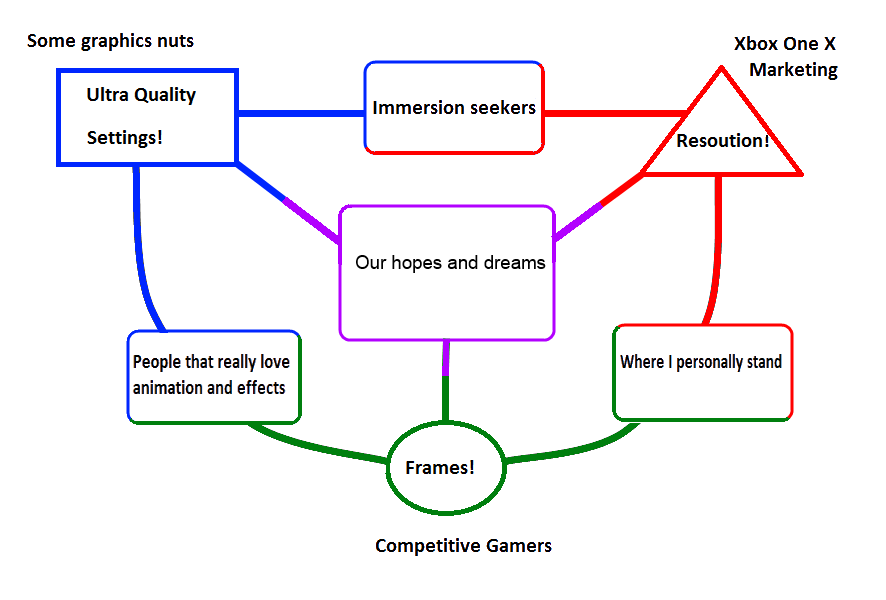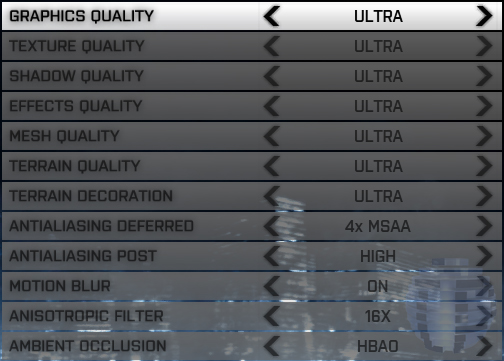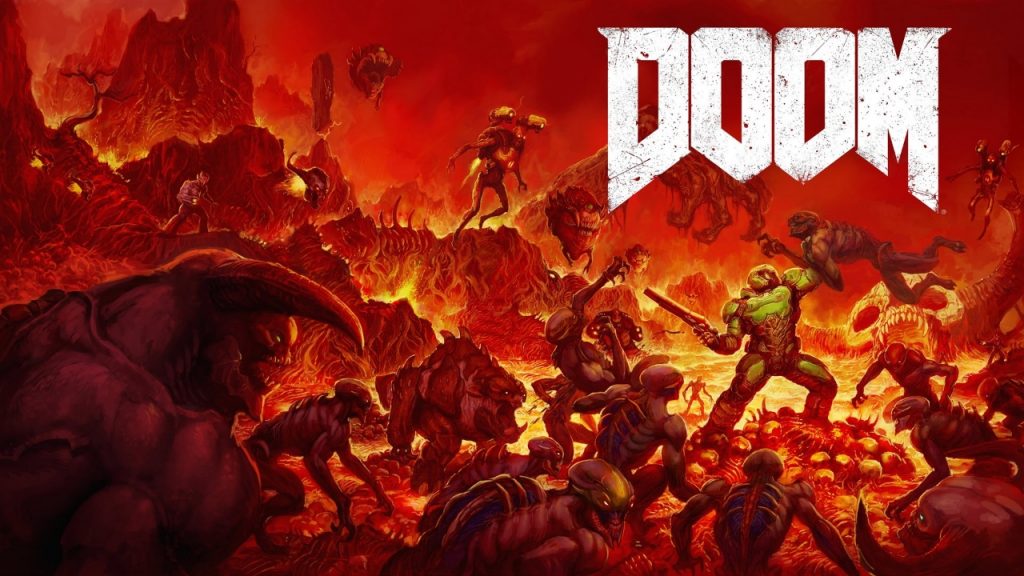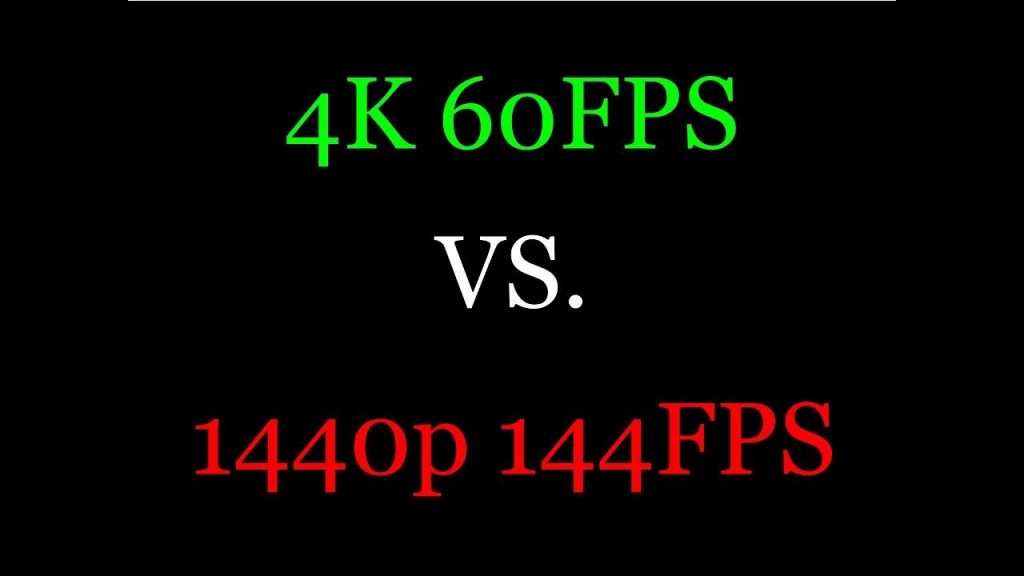
GPU’s are getting faster, with even midrange cards able to drive modern games on ultra settings with higher than your bog-standard 60 fps at 1080p. At this point, the question of whether to use a higher frame rate or higher resolution needs to be addressed.
The real Triad of Choice
Of foremost importance here is that resolution and frame rate are two parts of a triad of factors and choices we PC Gamers can make. The third, obviously, is settings, which, due to the current media hype about the new Xbox, people seem to have forgotten about, since console games usually have just one setting (Medium PC settings equivalent most of the time).
 A very professional diagram to better convey my point. You get it now, right?
A very professional diagram to better convey my point. You get it now, right?
Game settings
While settings are not a focus of this article, they should still be mentioned.
Some may be ready to sacrifice resolution or frame rate just to get a bit more bling in their games. Others go the other way and lower the game settings to high or even medium to get a boost in their desired choice in the triad.
Another important point is that certain game effects may actually obscure game world information. Competitive gamers often use lower foliage and smoke effects settings just to get the enemy players to pop out more easily without obstructions.
As for those who value immersion, not all settings are equal, either. Some strongly dislike chromatic aberration as it creates an appearance like one seen through a cheap camera instead of a character’s eyes. Others dislike depth of field and motion blurring effects since those can also seem artificial in a game world. Of course, everyone being different, choice is key.
Resolution
Resolution is one of the simpler image quality settings in games. The more there is, the better and the sharper an image can be. Resolution is of course tied to physical factors as well. Viewing distance, screen size and aspect ratio are also key but strongly depend on a person’s individual set-up and needs.
A good rule of thumb is that the higher the resolution, the clearer, better looking, and less aliased the image will be. There can be exceptions though. 2560×1440 might be very sharp on a 24-inch monitor, but viewed up close on a 50-inch TV—well, it obviously won’t look anywhere near as clean.
People who prefer high resolutions usually also like to pair them up with ultra settings and they love maximum immersion in their gaming adventures. Those that produce content also often favor the extra screen real estate afforded to them so as to split their workflow more easily or handle large photos and videos quickly.
Media like movies look great, and there is a good amount of internet content which can take some advantage of high resolutions. Most standard computing or office tasks are not really slowed down or limited as they are usually CPU limited or just not very fast or demanding for your video processor.
Frame Rates
Frame Rate is the frequency at which the display refreshes. While it won’t make your image look sharper, it does improve usability and makes animations and effects appear nicer on screen.
When it comes to gaming, a higher resolution is currently all the hype, though there remains a good number of people who would like to see a bigger emphasis on high and—more importantly– consistent frame rates, as these days almost every big game has some competitive multiplayer aspect which works better with high refresh rates. The reason for that is simple: the faster the screen refreshes the information from the game state, the more up-to-date the information will be, which is key in competitive games. And the advantages don’t stop there—the controls also feel better and react more quickly (effectively) with a high refresh rate.
People who prefer frame rate in game are usually more mechanics-inclined. The way the game plays and feels on a control level is what’s important, while immersion takes a back seat. I personally fall under this category: I like having smooth animation and very fast and responsive controls in my games and would sacrifice visuals to have them.
So which is better?
Well, this will be one of those articles that tells you that no option is clearly better than the other—what matters is what you enjoy. Ideally we’d get it all—the best visuals, at the highest resolutions with extreme frame rates, but often that would be far too expensive and sometimes actually impossible.
Are you going to watch movies or do video or photo editing? Or perhaps you’re a gamer, and it depends on the games you play and why you play them.
When it comes to most non-gaming tasks, higher resolution is generally the better choice, though not always. Again, it all depends on the task you’re going to do.
What’s the Multiplayer Experience like?
Ok, here I’ll take the liberty of dropping some opinions on you. Competitive games such as Dota2, League of Legends, Rocket League, StarCraft 2 and pretty much every First Person Shooter are better played on a higher frame rate. Of course, most self-respecting gamers would tell you the same thing.
The amount of smoothness and control gained from an increase in frame rate can really give you a sizable advantage against your opponents, though being actually good at the game still depends on you and you alone!
What about Single Player?
For more single player-oriented games, either choice is good as these games often boast some great graphics and scenery, so the high resolution will make all that look even better, though I myself always choose the higher frame rate for the smoothness it provides. There is usually no need to have a control advantage over a bunch of NPC’s. It’s all about the feeling, and if you’d rather have your game look fancier, you can go right ahead and increase that resolution! After all, it’s easier to brag about your great set-up with just a few screenshots.
However, for first-person games, I would still highly recommend the higher frame rate because the immersive nature of these games really allows the benefits to shine through. As much as certain companies like showing off their DOOM 4k 60fps capabilities, I would be much more impressed by a 1440p 144fps benchmark.
The one place even I would increase my resolution is in slower games such as strategies and city builders. They often have good, smooth animations but are CPU limited no matter what one does. At that point, we might as well just go for the looks.
How will these options affect my hardware?
Of course, to even consider upgrades like these we have to understand how they will impact your hardware.
Higher resolution targets your graphics card more while your processor probably won’t feel anything or might even get better performance if you have a CPU bottleneck. The reason for that is simple: with the GPU handling the pixels, the processor need not worry about resolution.
When it comes to a higher frame rate, it is also dependent on your CPU. You really need a well-balanced system as both your graphics card and processor have to do their part of the job much faster to achieve the desired frame rates.
In the end, this type of answer makes everyone sick—after all, people want to be sure of their upgrade. I personally recommend most people go with the high frame rate, though it does depend on your plans and preferences.
If you care more about mechanics and control, frame rate is the way to go, but if it’s full immersion in a game with great visuals and effects you’re after, then certainly go for the resolution option. There is no one better option, as long as you don’t game below 30fps!























